Lancia Ypsilon 2001 User Manual
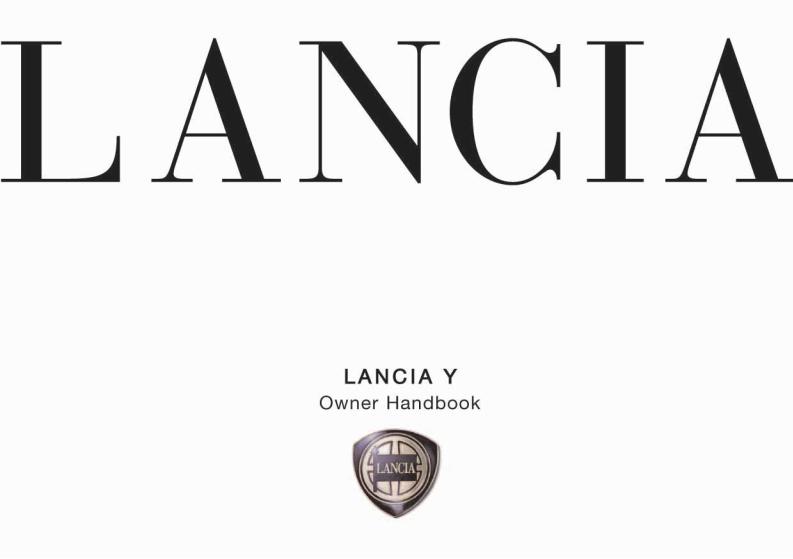

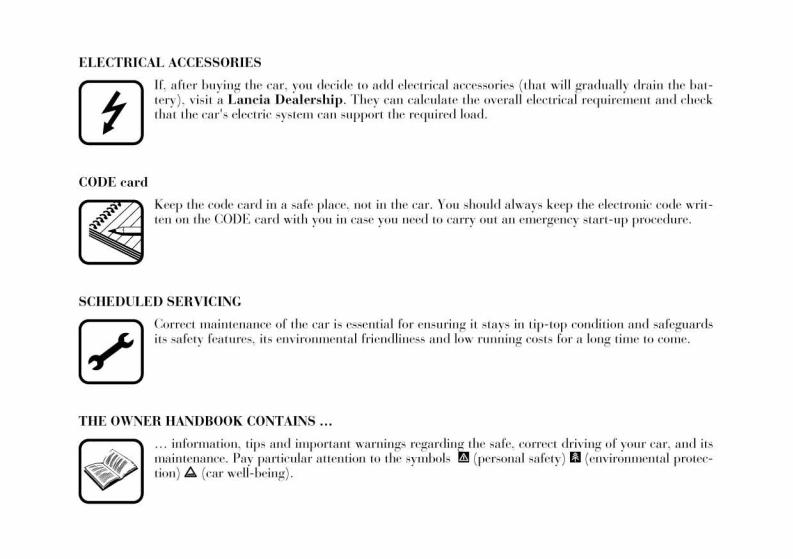

Congratulations and thank you for choosing LANCIA.
We have written this handbook to help you appreciate all the fine qualities of your car.
You should read it right through before taking to the road for the first time.
You will find information, tips and important warnings regarding the driving of the car to help you derive the maximum from your LANCIA’s technological features. You will also discover all its special features and find very valuable information for your car's care, maintenance, driving safety and running which will help you keep your car in tip-top condition for a long time to come.
The enclosed LANCIA Warranty Booklet lists the services you have acquired and contains details on the following:
•the Warranty Certificate with the terms and conditions for maintaining it
•the range of additional services available to LANCIA Owners.
We are sure that these instruments will help you easily attune to and appreciate both your new car and the LANCIA team that will be on hand to provide you with any assistance you may require.
Best regards and have a good trip.
This Owner Handbook describes all the Lancia Y versions. As a consequence, you should consider only the information which is related to the engine and bodywork version of the car you purchased.

TRAVELLING SAFELY AND PROTECTING THE ENVIRONMENT
Safety and respect for the environment are the guidelines that inspired the Lancia Y’s design from the drawing board onwards.
This concept has meant that the Lancia Y has been able to face and pass the strictest safety tests. So much so that, from this point of view, the car is the best in its class and has already incorporated features that will become compulsory in the years to come.
Ongoing research into new and effective features to help safeguard the environment makes the Lancia Y a car to imitate for this reason as well.
All versions are in fact equipped with environmental protection devices that reduce harmful exhaust fumes in compliance with the limits provided for by current legislation.
What’s more, it is totally recyclable. It has been designed to ensure a correct ecological treatment and recycling of all its component materials at the end of its life. When the time comes for your Lancia Y to be scrapped your LANCIA Dealership is committed to helping you to ensure that it is totally recycled. Nature benefits in two ways: nothing is wasted or thrown away and there is a correspondingly smaller need for new raw materials.

SAFEGUARDING THE ENVIRONMENT
The design and production of the Lancia Y has eliminated the use of a whole series of polluting materials and led to the perfection of devices that can reduce or considerably curtail harmful influences on the environment. The Lancia Y is consequently ready to travel well ahead of the most stringent international pollution control standards.
USE OF MATERIALS THAT DO NOT HARM THE ENVIRONMENT
None of the car’s components contain asbestos. Padding and the air conditioning system do not contain CFC’s (Chlorofluorocarbides), gases considered responsible for the destruction of the ozone layer. None of the colourings and anti-corrosion coatings of the nuts and bolts contain airor water-table-pol- luting cadmium or chromates, but environmentally-friendly substances.

DEVICES FOR REDUCING ENGINE EMISSIONS
Three-way catalytic converter (catalytic exhaust pipe)
Carbon monoxide, nitrogen oxides and unburnt hydrocarbons are the main harmful components in exhaust gases.
The catalytic exhaust pipe and the devices connected to it are a “miniature laboratory” where a very high percentage of these components are converted into harmless substances.
This conversion is aided by minute particles of precious metals on the ceramic core enclosed in the stainless-steel container.
Lambda sensors
All are fitted with these devices. They ensure that air and fuel are constantly mixed in the correct proportion. This is a fundamental condition for proper engine and catalytic converter operation.
Evaporation control systems
As it is impossible to stop the build-up of petrol fumes even when the engine is not running, the system traps them in a special container holding active carbon. They are sucked in from here and burnt while the engine is running.
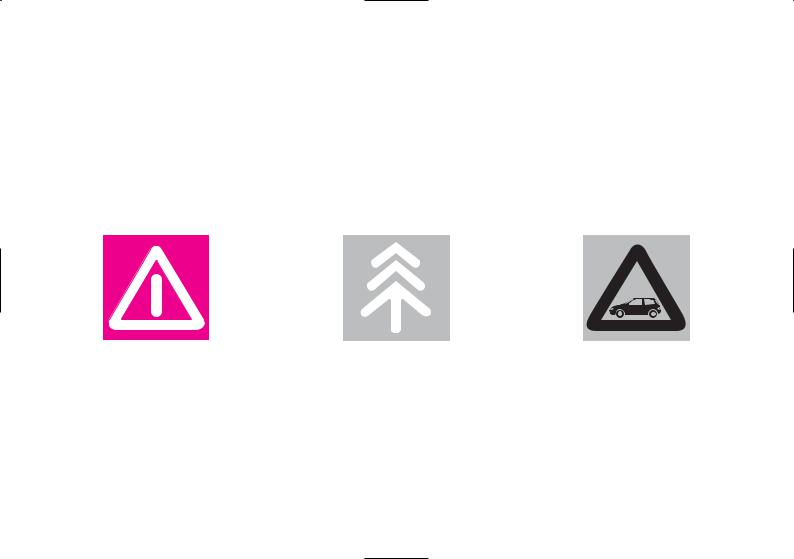
THE SIGNS TO HELP YOU DRIVE CORRECTLY
The signs you see on this page are very important. They highlight those parts of the handbook where, more than elsewhere, you should stop for a minute and read carefully.
As you can see, each sign has a different symbol to make it immediately clear and easy to identify the subjects in the different areas:
Personal safety.
Important. Total or partial failure to follow these instructions can place driver, passengers or others in serious danger.
Environmental protection.
This shows you the correct procedures to follow to ensure the car will not harm the environment.
The car’s well-being.
Important. Total or partial failure to follow these instructions will result in the risk of serious damage to the car and sometimes invalidates the warranty as well.

SYMBOLS |
DANGER SYMBOLS |
of the precautions to be taken as regards that particular component.
A list of the symbols to be found on your Lancia Y is given below with the name of the component to which it relates at the side of it.
Fan
May cut in automatically when the engine is off.
Expansion tank
Do not remove the cap when the engine is hot.
Coil
High voltage.

PROHIBITION SYMBOLS |
|
|
Passenger’s airbag |
Keep away from naked |
Do not install child safety |
|
seats on the front passenger |
|
seat. |
|
Jack |
Keep children away. |
Do not use for carrying |
|
out repairs. |
under pressure.
Heat shields
Do not touch.

WARNING SYMBOLS
reservoir. Use only the fluid specified section “Capacities”.
Brake circuit
Do not exceed the maxi-
 mum fluid level in the reservoir. Use only the fluid specified
mum fluid level in the reservoir. Use only the fluid specified
section “Capacities”.
Engine
Use only the lubricant specified in the section “Ca-
pacities”.
OBLIGATION SYMBOLS
Windscreen wiper
Use only the fluid specified in the section “Capaci-
ties”.
Battery
Protect your eyes.
MAX 700 kg. |
Jack
Maximum lifting load.
Battery
See the Owner Handbook.

CONTENTS
GETTING TO KNOW YOUR CAR
DRIVING YOUR CAR
IN AN EMERGENCY
CAR MAINTENANCE
TECHNICAL SPECIFICATIONS
ACCESSORY INSTALLATION
INDEX

GETTING TO KNOW YOUR CAR
You are recommended to read this chapter sitting comfortably in your new Lancia Y. In this way you will be able to identify the parts described immediate and see for yourself what you have just read.
In short, you will increase your knowledge of your Lancia Y with its controls and other devices. Later, when you start the engine and join the traffic you will make a host of other pleasant discoveries.
DASHBOARD ................................................. |
11 |
THE LANCIA CODE SYSTEM ....................... |
13 |
IGNITION SWITCH ........................................ |
16 |
INDIVIDUAL SETTINGS ............................... |
17 |
SEAT BELTS .................................................. |
21 |
TRANSPORTING CHILDREN SAFELY .......... |
26 |
INSTRUMENT PANEL ................................... |
29 |
INSTRUMENTS ............................................. |
31 |
WARNING LIGHTS ........................................ |
34 |
HEATING AND VENTILATION ..................... |
37 |
CLIMATE CONTROL SYSTEM....................... |
40 |
STEERING COLUMN STALKS ...................... |
41 |
CONTROLS .................................................... |
43 |
INTERIOR EQUIPMENT ................................ |
45 |
SUNROOF ...................................................... |
48 |
DOORS ........................................................... |
49 |
BOOT ............................................................. |
51 |
BONNET ........................................................ |
53 |
SKI AND ROOF RACKS ................................. |
55 |
HEADLIGHTS ............................................... |
55 |
ABS ................................................................ |
56 |
FRONT AND SIDE AIRBAGS .......................... |
58 |
EOBD SYSTEM ............................................... |
63 |
SOUND SYSTEM ........................................... |
64 |
RADIO-NAVIGATION SYSTEM ..................... |
65 |
CELLULAR PHONE SETUP........................... |
66 |
FUEL TANK CAP............................................ |
67 |
10

DASHBOARD
The presence and position of instruments and warning lights may vary according to the version of the car.
P4C00364
1. Fixed air vents for side windows - 2. Left-hand stalk (direction indicators/headlamps) - 3. Airbag - 4. Right-hand stalk (windscreen wiper/rear window wiper) - 5. Instrument panel - 6. Button panel with climate control button - 7. Radio-navigator or sound system - 8. Front window demisting - 9. Passenger side airbag - 10. Speaker housing (tweeter) - 11. Side air vent - 12. Glove compartment - 13. Air distribution knob - 14. Air recirculation slider - 15. Fan knob - 16. Air temperature adjustment knob - 17. Ignition switch - 18. Steering wheel adjustment lever - 19. Bonnet release lever - 20. Horn - 21. Object tray/Fusebox.
11
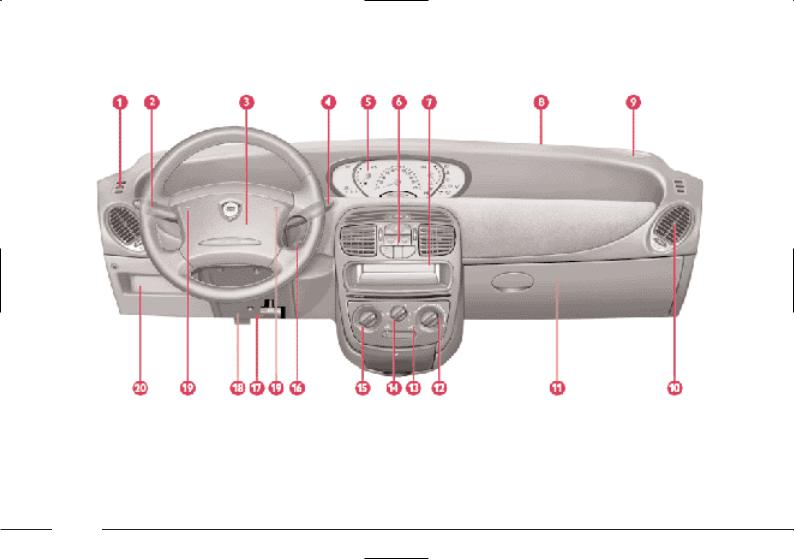
The presence and position of instruments and warning lights may vary according to the version of the car.
P4C00365
1. Fixed air vents for side windows - 2. Left-hand stalk (direction indicators/headlamps) - 3. Airbag - 4. Right-hand stalk (windscreen wiper/rear window wiper) - 5. Instrument panel - 6. Button panel - 7. Sound system housing - 8. Front window demisting - 9. Speaker housing (tweeter) - 10. Side air vent - 11. Glove compartment - 12. Air distribution knob - 13. Air recirculation slider - 14. Fan knob - 15. Air temperature adjustment knob - 16. Ignition switch - 17. Steering wheel adjustment lever - 18. Bonnet release lever - 19. Horn - 20. Object tray/Fusebox.
12

THE LANCIA
CODE SYSTEM
To further protect your car from attempted theft, it has been fitted with an electronic engine immobiliser system called “Lancia CODE”, which is currently considered the most effective way of protecting your car against theft. This system is automatically activated each time the engine is switched off. Each ignition key, in fact, contains an electronic device which modulates a radio-frequency signal emitted by a special aerial during ignition. The modulated signal is a “password” with which the control unit recognises the key. Engine ignition is enabled only if the key is recognised by the system.
P4C00056
fig. 1
THE KEYS
Three types of key (fig. 1) are supplied with the car.
The car is always supplied with a single A key and B or C keys depending on the version:
–version without remote control, two B keys;
–versions with door lock/unlock remote control, one B key and one C key;
Key A, with a burgundy grip, is the “master” key. Only one of these keys is provided, and it is used to store the codes of new keys replacing ones that have been lost or damaged, or when storing duplicate key codes. Given its importance, it should be kept in a safe place (not in the car) and only be used when absolutely necessary.
No repairs can be carried out on the Lancia CODE system or the engine control unit if this key is lost.
Key B, with a black grip, is the key that is to be used normally. It will:
–start the engine
–unlock/lock the doors
–unlock/lock the boot
–unlock/lock the fuel tank cap.
–deactivate the passenger airbag.
Key C, (which may be supplied as an alternative to the B key), has the same functions as key B, plus the remote control function for the door lock/unlock system.
The key is supplied together with the CODE card (fig. 2) which bears:
D - the electronic code to be used for emergency starting (see “In an emergency”);
P4C00057
fig. 2
13

E - the mechanical key code to be given to the LANCIA Dealership when ordering duplicate keys;
F - the spaces for stickers bearing the code of any remote controls provided.
The code numbers on the CODE card and the key with the burgundy grip must be kept in a safe place.
You should keep the electronic code written on the CODE card with you at all times in case it is necessary to start the car using the emergency procedure.
OPERATION
Each time the ignition key is turned to STOP or PARK, the protection system will immobilise the engine.
When the key is turned to MAR at engine startup:
1)If the code is recognised, the warning lamp ¢ on the instrument panel will flash briefly; this means that the protection system has recognised the key code and disabled the engine immobiliser; turn the key to AVV to start.
2)If the code is not recognised, the warning lamp ¢ and the warning
lamp  will remain lit. Should this happen, turn the key back to STOP and then to MAR; if the en-
will remain lit. Should this happen, turn the key back to STOP and then to MAR; if the en-
gine remains immobilised, try using the other keys supplied with the car.
If you are still unable to start the engine, use the emergency starting procedure (see “In an emergency”), and take your car immediately to the nearest LANCIA Dealership.
When travelling with the ignition key on MAR:
1) If the warning lamp ¢ lights up while the car is moving, it means that the system is running a self-diagnosis (e.g. due to a voltage drop).
The first time you stop you can test the system: turn the ignition key to STOP to switch off the engine then to MAR again. Warning lamp ¢ will switch on and should switch off again after about 1 second.
If the warning light remains on, repeat the previous operations again leaving the key at STOP for more than 30 seconds. If the fault persists, contact a LANCIA Dealership.
2) If the warning lamp ¢ flashes it means that the car is not protected by the immobiliser. Contact your LANCIA Dealership immediately and get them to store the codes of all the keys in the memory.
IMPORTANT The electronic components inside the key may be damaged if the key is subjected to sharp knocks.
IMPORTANT Each key given with the car has its own code, different from all the others, which must be stored in the memory of the system’s control unit.
14
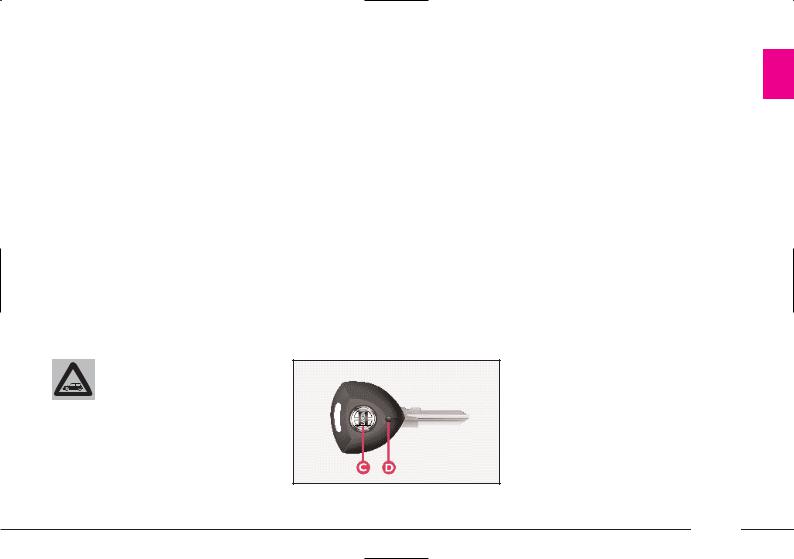
DUPLICATE KEYS
If you ask for extra keys, remember that all the keys, both the new ones and those you already possess, must be stored in the memory (up to a maximum of 7). Go directly to your nearest LANCIA Dealership, taking with you the burgundy “master” key, all the keys in your possession and the CODE card. The LANCIA Dealership may ask you to demonstrate that you own the car.
The codes of any keys that are not available when the new storage procedure is carried out will be deleted from the memory to prevent any lost keys being used to start the car.
DOOR LOCK/UNLOCK
REMOTE CONTROL (fig. 3)
The remote control is built into the ignition key. It consists of a button C and a LED D. The button operates the control and the LED flashes while the transmitter is sending the code to the receiver.
This a radio-frequency remote control and must be used close to the car.
Ministerial homologation
With respect to the legislation in force in each country on the use of radio frequencies:
–the market specific homologation codes are given in the chapter “Accessory installation”;
–the homologation code is printed on the ignition key-remote control for the markets which require it.
The burgundy key, plus all the other keys, and the CODE card must be
handed over to the new owner when selling the car.
fig. 3
P4C00058
15

CHANGING THE BATTERIES (fig. 4)
Change the remote control batteries when the LED on the remote control flashes once only when pressed. Change the batterie with a similar type as follows: open the plastic covers; insert the new batterie respecting the polarity shown; close the plastic covers.
Used batteries are an environmental hazard. Dispose of them in appropri-
ate containers as prescribed by the law. Alternatively, take the batteries to a LANCIA Dealership who will dispose of them correctly.
P4C20003
fig. 4
IGNITION SWITCH
The key can turn through four positions (fig. 5):
–STOP: engine off, key can be removed and the steering column is locked. Some electrical devices can be used (e.g. sound system, central door lock, etc.).
–MAR: drive position. All electrical devices can be used.
–AVV: to start the engine.
P4C00324
– PARK: engine off, parking lights lit, key can be removed, steering column locked. Press button A to turn the key to PARK.
If the ignition switch has been tampered with (e.g. someone has tried to steal your car), get a LANCIA Dealer-
ship to make sure it is still functioning properly before you start driving again.
Always remove the key when leaving the car so that the controls cannot be
accidentally activated. Engage the handbrake, and if the car is facing uphill engage the first gear too. With the car facing downhill engage the reverse gear. Never leave children alone in the car.
fig. 5
16

STEERING COLUMN LOCK
To set: remove the ignition key from the STOP or PARK position, and turn the steering wheel until it locks.
To release: move the steering wheel slightly as you turn the ignition key to
MAR.
Never remove the ignition key while the car is moving. The steering wheel
would automatically lock as soon as you tried to turn it. This also applies when the car is being towed.
INDIVIDUAL
SETTINGS
Adjustments must be made only when the car is stationary.
FRONT SEATS
Moving the seat backwards or forwards
Lift the lever A (fig. 6) and push the seat forwards or backwards. You are in the correct position for driving when your hands are resting on the steering wheel rim and your arms are slightly bent.
Once you have released the lever, check that the seat is firmly locked in the
runners by trying to move it back and forth. Failure to lock the seat in place could result in the seat moving suddenly and dangerously.
Height adjustment
Pull out telescopic lever B (fig. 6); raise or lower it as required.
IMPORTANT The adjustment must only be made with someone sitting in the seat.
Adjusting the reclining seat back
Turn knob C (fig. 6).
P4C00017
fig. 6
17

Lumbar support adjustment
This adjustment gives better back support.
To adjust, turn knob D (fig. 7).
HEAD RESTRAINTS (fig. 8)
Remember: head restraints should be adjusted to support the back of your
head and not your neck. Only if they are in this position will they be able to provide effective protection in the event of a rear-end shunt.
The height of the front head restraints can be adjusted to ensure that the person’s head rests on it correctly.
The rear head restraints (fig. 9) can be removed to fold the seat back:
– press tabs A and remove the head restraint.
To refit, fit it in the holes until you hear a click.
P4C00159 |
P4C00390 |
P4C00391 |
fig. 7 |
fig. 8 |
fig. 9 |
18

ACCESS TO THE BACK SEATS (fig. 10)
You can easily get into the back seats from either side.
Pull handle A up to fold the seat back down and slide the seat forwards (only for the passenger seat).
A recovery device with memory makes it possible to automatically return the passenger seat to the position it was in previously. Always ensure the seat is locked properly in its runners by trying to move it back and forth.
STEERING WHEEL (fig. 11)
The wheel must only be adjusted while the car is stationary.
To adjust the height of the steering wheel:
1)Move lever A to position 1.
2)Adjust the steering wheel.
3)Return the lever to position 2 to lock the wheel in place again.
Do not push on the power steering limit switch for more than 15 seconds with
the engine running. This causes noise and could damage the system.
DRIVING MIRROR (fig. 12)
This mirror is adjustable. Move lever A to shift the mirror to the following positions:
1)normal position;
2)anti-dazzle position.
The mirror is also fitted with a safety device that releases the mirror in the event of impact.
P4C00396 |
P4C00392 |
P4C00062 |
fig. 10 |
fig. 11 |
fig. 12 |
19

DOOR MIRRORS
Hand-adjustable (fig. 13)
Turn knob A inside the car.
Electrically-adjustable (fig. 14)
The mirrors can only be adjusted electrically when the ignition key is at
MAR.
All you need to do is press any of the four directions on switch A to perform this operation.
Use switch B to select the mirror (right or left) you want to adjust.
Electrically folding mirrors have an electrical device for demisting the mirrors that comes on automatically when you turn on the rear window heater.
If the mirror makes it difficult to get through narrow gaps, fold it from po-
sition 1 to position 2 (fig. 15).
When driving the mirrors should always be in extended position 1.
The external curved rear view mirrors slightly alter the perception of distance.
P4C00063 |
P4C00023 |
P4C00317 |
fig. 13 |
fig. 14 |
fig. 15 |
20

SEAT BELTS
HOW TO USE THE SEAT BELTS (for the front and back side seats) (fig. 16)
Pull the seat belt out gently; if the belt jams, let it rewind for a short stretch, then pull it out again without jerking.
To fasten the seat belts, take the tongue of fastener A and push it into buckle B until you hear it click.
P4C00397
The lower part of the front seat belts slides on a bar to make it easier for you to get hold of the belt when putting it on.
Press button C to unfasten the belts. Guide the belt with your hand as it rewinds to prevent it twisting.
The belt unwinds from the reel and automatically adjusts to fit the passenger’s body, allowing him or her to move in complete freedom. When the car is parked on a slope the reel may lock. This is quite normal.
The reel mechanism also prevents the webbing coming out when it is jerked or if the car brakes sharply, is in a collision or when taking bends at high speed.
For maximum safety, keep the back of your seat upright, lean back into it and make sure the seat belt fits
closely across your chest and hips.
ADJUSTING THE FRONT SEAT
BELT HEIGHT (fig. 17)
Make the height adjustment when the car is stationary.
Always adjust the height of the seat belt to fit the person wearing it. This could greatly reduce the risk of injury in the case of collision.
P4C00050
fig. 16 |
fig. 17 |
21

The belt is adjusted properly when the webbing passes approximately halfway between the edge of the shoulder and the neck.
The seat belt can be adjusted to one of four different heights.
To lift the belt
Lift loop B (fig. 17) to the required position.
To lower the belt
Press knob A (fig. 17) and move loop B down to the position required.
After you have made the adjustment, always make sure the slider the loop is
attached to catches firmly in one of the fixed positions and cannot move. To check this, release the knob and push again so that it can catch into place if it is not properly latched in position.
PRETENSIONERS
The Lancia Y is fitted with pretensioners to enable the seat belts to offer even more effective protection. These devices “feel” that a violent collision is in progress, via a sensor, and call in a few inches of webbing. The pretensioner, therefore, ensures the belt is adhering perfectly to the body before it begins to stop the wearer moving forward.
When the seat belt locks, it indicates the pretensioner has been activated. The belt will not wind back even if accompanied manually.
A small amount of smoke may be noticed: this is not harmful and does not indicate the beginning of a fire.
The pretensioner needs no maintenance or lubrication. Any modification to its original features will nullify the pretensioner’s effectiveness. If water or mud accidentally get into the pretensioner as a result of floods or storms, the device must be replaced.
For maximum pretensioner protection, make sure your seat belt fits snugly to your chest and hips.
Never dismantle or tamper with pretensioner components. Any intervention must be performed by skilled
and qualified personnel. Always have interventions performed at a LANCIA Dealership.
22

The pretensioners can only be used once. After they have been activated,
have them replaced at a LANCIA Dealership.
The device was made to last 10 years from the manufacturing date shown in the specific adhesive label. The pretensioners must be changed before expiry.
Work involving knocks, vibrations or localised heating (maximum 6 hours at over 100° C) near the preten-
sioner unit can cause damage or even trigger the device. Vibrations caused by uneven roads or accidentally driving over small bumps (e.g. curbs), etc., do not fall into this category. See a LANCIA Dealership if work is required on the device.
USE OF THE REAR SEAT BELTS (fig. 18)
The belts for the back seats must be worn as shown.
To ensure the correct buckle is used, the tongues of the side seat belts will not fit into the buckle of the middle seat belt.
You should put the belt on when you are sitting upright and leaning back in your seat.
IMPORTANT The seat belt has been adjusted correctly when it fits snugly across the wearer’s hips.
Remember, in the case of a violent collision, back seat passengers not wear-
ing seat belts also represent a serious danger to the passengers in the front.
P4C00066
fig. 18
23

USING THE REAR CENTRAL
SEAT BELT (fig. 19)
To fasten the seat belt: push the tongue of fastener A into slot B of the buckle until you hear it click.
To unfasten the seat belt: press button C.
To adjust the seat belt: slide the webbing through adjuster D, pulling end E to shorten it and length F to lengthen it.
IMPORTANT The belt is adjusted properly when it fits closely across the hips.
P4C00067
GENERAL INSTRUCTIONS FOR THE USE OF THE SEAT BELTS
The driver is responsible for respecting and making sure the passengers respect the local rules on the use of seat belts.
Make sure all seat belts |
(both front and back) are |
fastened at all times! You |
increase the risk of serious injury |
or death in a collision if you travel |
with the belts unfastened even if |
your car is fitted with the airbag |
system. |
The webbing must not be twisted. The upper section must pass across the
shoulder and chest diagonally. The lower part must fit closely across the passengers’ hips and not the abdomen, to prevent them sliding forward (fig. 20). Do not use clips, fasteners, etc. to prevent the belt adhering to the passenger’s body.
P4C00068
fig. 19 |
fig. 20 |
24

protect them both (fig. 21).
If the belt has undergone serious strain, for example following an accident, replace the belt with its anchorages,
the anchorage screws and the pretensioner. Even if there is no visible damage, the resistance properties may have deteriorated.
P4C00173
fig. 21
SEVERE DANGER:



 if the car has a pas-
if the car has a pas- 
 senger airbag, do not place the child seat on the
senger airbag, do not place the child seat on the
front seat.
Seat belts must also be worn by expectant mothers: the risk of injury in the case of accident is much greater for them, too, if they do not have a seat belt on.
Of course, expectant mothers must position the lower part of the belt very low down so that it passes under the stomach, (fig. 22).
P4C00069
fig. 22
HOW TO MAINTAIN THE SEAT BELTS
IN GOOD WORKING ORDER
1)When wearing the seat belts, always ensure they are not twisted but lie flat across the chest and hips and ensure that they run easily and freely.
2)Following a serious accident, replace the belt being worn at the time, even if it does not seem damaged.
3)When cleaning the belts, wash them by hand with water and neutral soap, rinse them and let them dry in the shade. Do not use strong detergents, bleach, colouring or any other chemical substance that could weaken the fibres.
4)Do not allow the reels to get wet: they are only guaranteed to work properly if they remain dry.
25

TRANSPORTING CHILDREN SAFELY
For the best protection in the event of a crash, all passengers must be seated and wearing adequate restraint systems.
This is especially relevant for children.
A child’s head, in respect to that of an adult, is larger and heavier in relation to the body. Moreover the muscular and bone structure is not fully developed. For these reasons, children require specific restraint systems, different to those required by adult passengers.
The results of research on the best child restraint systems are contained in the European Standard ECE-R44. This Standard enforces the use of restraint systems classified in four groups, (fig. 23):
Group 0 weight 0 - 10 kg
Group 1 weight 9 - 18 kg Group 2 weight 15 - 25 kg
Group 3 weight 22 - 36 kg.
The groups partially overlap. This is because there are systems which cover more than one weight group.
All restraint systems must show homologation data and control marks on a tag securely fastened to the system and that cannot be removed.
Children weighing more than 36 kg and taller than 1.5 m are, with reference to restraint systems, considered adults and can wear normal seat belts.
We recommend using Lineaccessori LANCIA child restraint systems for each weight group as they have been specifically designed for LANCIA vehicles.
P4C00312
fig. 23
26

We recommend sitting children on the rear seat. This is the most protected
position in the event of a crash. Never fit child restraint systems in the front passenger seat in vehicles with a passenger airbag. The inflated airbag could cause even fatal injury, regardless of the severity of the crash which triggered it off.
Children can sit in the front passenger seat in cars with passenger side airbag only if the system has been deactivated. In this case, always make sure that the amber instrument panel warning light is on to confirm that the airbag has been deactivated.
P4C00310
fig. 24
GROUP 0
Babies up to 10 kg are to be seated in a cot type seat facing backwards and supporting the child’s head. This ensures there is no stress on the child’s neck in sudden deceleration
The cot is secured with the seat belts as shown in (fig. 24). The child must be strapped to the carrier.
The figure is only an ex- |
||
ample for the installation. |
||
Follow |
the |
instructions |
provided with the restraint system |
||
you are using. |
|
|
P4C00311
fig. 25
GROUP 1
Children from 9 kg are to be seated facing forward in child seats with front cushions, (fig. 25). The vehicle seat belt secures both seat and child.
The figure is only an ex- |
||
ample for the installation. |
||
Follow |
the |
instructions |
provided with the restraint system |
||
you are using. |
|
|
There are child restraints for Groups 0 and 1 which are fastened with the vehi-
cle seat belts by means of an attachment on the seat back. The child is then secured to the seat with specific straps. Due to their weight, child seats can be dangerous if they are not fitted correctly (e.g. by placing a cushion between the seat and the belts). Always follow carefully the installation instructions provided with the child restraint system you are using.
27
